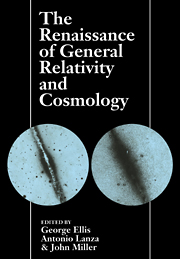 The Renaissance of General Relativity and Cosmology
The Renaissance of General Relativity and Cosmology Book contents
- Frontmatter
- Contents
- Author Addresses
- 1 Introduction
- 2 Exact and inexact solutions of the Einstein field equations
- 3 Inertial forces in general relativity
- 4 Relativistic radiation hydrodynamics: a covariant theory of flux-limiters
- 5 Relativistic gravitational collapse
- 6 The cosmic censorship hypothesis
- 7 The Kerr metric: a gateway to the roots of gravity?
- 8 Galactic astronomy since 1950
- 9 Galaxy distribution functions
- 10 Nonlinear galaxy clustering
- 11 Quasars: progress and prospects
- 12 Decaying neutrinos in astronomy and cosmology
- 13 Cosmological principles
- 14 Anisotropic and inhomogeneous cosmologies
- 15 Mach's principle and isotropic singularities
- 16 Implications of superconductivity in cosmic string theory
- 17 The formation and evaporation of primordial black holes
- 18 Evaporation of two dimensional black holes
- 19 Topology and topology change in general relativity
- 20 Decoherence of the cluttered quantum vacuum
- 21 Quantum non-locality and complex reality
- 22 The different levels of connections between science and objective reality
5 - Relativistic gravitational collapse
Published online by Cambridge University Press: 15 December 2009
- Frontmatter
- Contents
- Author Addresses
- 1 Introduction
- 2 Exact and inexact solutions of the Einstein field equations
- 3 Inertial forces in general relativity
- 4 Relativistic radiation hydrodynamics: a covariant theory of flux-limiters
- 5 Relativistic gravitational collapse
- 6 The cosmic censorship hypothesis
- 7 The Kerr metric: a gateway to the roots of gravity?
- 8 Galactic astronomy since 1950
- 9 Galaxy distribution functions
- 10 Nonlinear galaxy clustering
- 11 Quasars: progress and prospects
- 12 Decaying neutrinos in astronomy and cosmology
- 13 Cosmological principles
- 14 Anisotropic and inhomogeneous cosmologies
- 15 Mach's principle and isotropic singularities
- 16 Implications of superconductivity in cosmic string theory
- 17 The formation and evaporation of primordial black holes
- 18 Evaporation of two dimensional black holes
- 19 Topology and topology change in general relativity
- 20 Decoherence of the cluttered quantum vacuum
- 21 Quantum non-locality and complex reality
- 22 The different levels of connections between science and objective reality
Summary
INTRODUCTION
I started as a research student with Dennis Sciama in 1971 at the beginning of his time at Oxford, after he had transferred there from Cambridge, and was subsequently a post-doc with his groups in Oxford and Trieste. It is a great pleasure to have the opportunity of contributing to this book.
In the renaissance of general relativity and cosmology, which is our subject here, one of the central themes has been the study of relativistic gravitational collapse, black holes and neutron stars. At the beginning of my research work, Dennis emphasized to me the role which was going to be played in this by numerical computing and he pointed me in that direction despite some initial reluctance on my part. Applying general relativity to real problems in the real world is a complicated business but gradually it has entered the mainstream of astrophysics to the extent that it now no longer seems to be an exotic curiosity but has come of age as an equal member of the collection of physical theories which are brought into service in attempting to explain how things work. Computing has played a key role in this, making it possible to move beyond theoretical models which have been simplified to the point where analytical techniques are sufficient for studying them, to the development of more detailed models which probe more deeply into the consequences of the theory and come closer to contact with possible observations.
- Type
- Chapter
- Information
- The Renaissance of General Relativity and CosmologyA Survey to Celebrate the 65th Birthday of Dennis Sciama, pp. 73 - 85Publisher: Cambridge University PressPrint publication year: 1993


